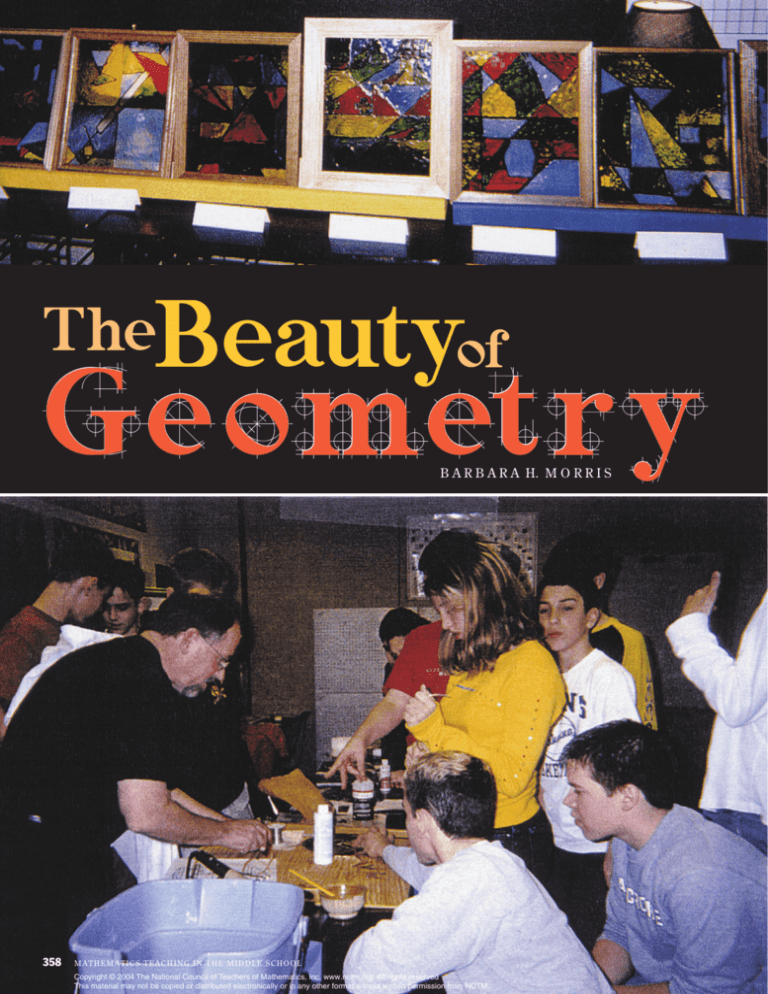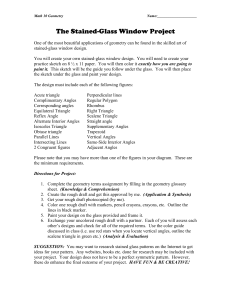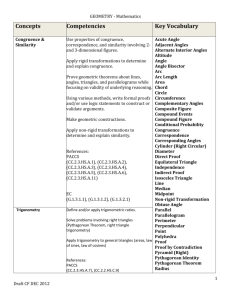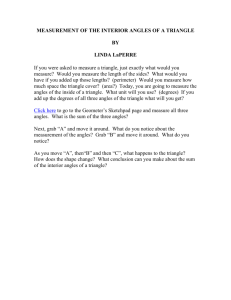
TheBeautyof
Geometry
B A R B A R A H. M O R R I S
358
MATHEMATICS TEACHING IN THE MIDDLE SCHOOL
Copyright © 2004 The National Council of Teachers of Mathematics, Inc. www.nctm.org. All rights reserved.
This material may not be copied or distributed electronically or in any other format without written permission from NCTM.
PHOTOGRAPHS BY KATIE MCCORMICK; ALL RIGHTS RESERVED
S
TAINED-GLASS-WINDOW DESIGN IS AN
aesthetically pleasing and realistic application of geometry. Examples of these designs
date back to medieval times. Frank Lloyd
Wright’s stained-glass creations are modern examples
of combinations of light, color, and form that fascinate
and delight the viewer (Carli 2001). This fascination
and delight can be brought to life for students with a
stained-glass-window geometry project.
Geometry is often thought of as being a topic that is
dull and that requires analytical thought. A stainedglass-window project, however, can create interest and
enthusiasm in middle school mathematics classes. It
incorporates aspects of the Geometry Standard found
in Principles and Standards for School Mathematics
(NCTM 2000). It also provides a vehicle for addressing
the Process Standards of problem solving, reasoning
and proof, communication, connections, and representation. As students participate in the project, they analyze characteristics and properties of two-dimensional
geometric shapes when they make a glossary of geometric terms, when they create a stained-glass design,
and when they assess another student’s work. During
these activities, they also develop arguments about
geometric relationships and use symmetry, visualization, spatial reasoning, and geometric modeling. The
higher levels of Bloom’s Taxonomy (application, analysis, synthesis, and evaluation) are emphasized
throughout the assignment (see fig. 1).
Seventh-grade honors prealgebra students from
three middle schools participated in this project. The
students first studied stained-glass designs from ancient history to those of Frank Lloyd Wright and other
modern artists. They did research on the Internet and
in the library and viewed a videotape on Frank Lloyd
Wright and his works. One activity that created enthusiasm was a hands-on demonstration of stained-glass
art, in which one parent dazzled the students with his
ability to produce fascinating creations. His enthusiasm was contagious. Students were also able to discover geometric configurations in cards and stationery, buildings, artwork, furniture, and wallpaper.
The first project requirement was to write a definition, find an example, draw an illustration, and determine an application for each of the essential geometBARBARA MORRIS, morrisb@gips.org, is the Mathematics
Gifted Intervention Specialist in the middle schools at
Gahanna-Jefferson Schools in Gahanna, OH 43230. She is
interested in working collaboratively with teachers to challenge
all students in their mathematical thinking.
The author wishes to acknowledge Katie McCormick,
mccormickk@gips.org, who teaches seventh-grade mathematics at Gahanna Middle School East in Gahanna, OH
43230. She designed the graphics for this project.
ric terms. The students’ assignment page (fig. 1)
listed twenty terms and the requirements for the project. A chart for the glossary of terms and an example
of how to use the chart was also given to students
(fig. 2). One teacher chose another format for the
glossary. Each term was written on the front of an
index card. The definition, example, illustration, and
application were placed on the back of the card. The
cards were then held together with a binder ring.
Students created original stained-glass-window designs that incorporated the twenty geometric figures.
Two copies of the blackline patterns were needed: one
copy was used as a guide under the glass and the other
was an assessment tool. The designs were then painted
The Stained-Glass-Window Project
One of the most beautiful applications of geometry can be
found in the skilled art of stained-glass-window design. From
the inspiring medieval creations such as the Rose Window in
the Cathedral of Notre Dame to the magnificent adornments
of Frank Lloyd Wright’s modern architecture, stained glass
has been used to lift the human spirit. The combination of
light, color, and form seems irresistibly fascinating.
You will create your own stained-glass-window design. You
will need to purchase an 8 in. × 10 in. picture frame and will paint
your final design on the glass of the frame. The design must include at least one of each of the following geometric figures:
Acute triangle
Complementary angles
Corresponding angles*
Equilateral triangle
Exterior angles*
Interior angles*
Intersecting lines
Isosceles triangle
Obtuse triangle
Parallel lines
Perpendicular lines
Regular polygon
Rhombus
Right triangle
Scalene triangle
Similar figures
Straight angle
Supplementary angles
Trapezoid
Vertical angles
*Angles formed when two parallel lines are cut by a transversal
Directions for project:
1. Complete the geometry terms assignment by filling in the
Geometry Glossary sheet. (Knowledge and Comprehension)
2. Create a rough draft of your design. (Remember that regular paper is 8 1/2 in. × 11 in., so you will need to cut the paper
to fit the 8 in. × 10 in. dimensions.) Your teacher must approve
this before you proceed. (Application and Synthesis)
3. Create a final paper copy of your design (use dark lines).
Your teacher will make a copy of this final design for use in item 5.
4. Paint your design on the 8 in. × 10 in. glass and frame it.
5. You will analyze another student’s design and find and mark
the 20 required geometric figures. (Analysis and Evaluation)
Fig. 1 The students received these directions for the stained-glass project.
V O L . 9 , N O . 7 . MARCH 2004
359
Geometry Glossary
Name ____________
Date _____________
Period ____________
Directions: Place the required terms in the Geometry Glossary that you will be creating. Please keep the
terms numbered and in alphabetical order. You will provide a definition, an example, and an application
for each term. Your grade will reflect how complete your definitions are and the quality of your examples
and applications.
TERM
Example:
Acute Angle
DEFINITION
EXAMPLE
An angle with a
measure between 0°
and 90°.
In a right triangle,
you will have one 90°
angle and two acute
angles.
P
m
APPLICATION
P = 60º
Fig. 2 The glossary, to be completed by students, containing all twenty terms
Geometry Project
Grade Sheet
Name ___________
Date ____________
Period ___________
POINTS EARNED
Geometry Terms
20
Rough Draft
20
Final Copy
20
Painted Frame
20
Analyze Another Design
20
Total
100
Fig. 3 The grade sheet helped to total all points for the project.
360
POINTS POSSIBLE
MATHEMATICS TEACHING IN THE MIDDLE SCHOOL
COMMENTS
%
PHOTOGRAPH BY KATIE MCCORMICK; ALL RIGHTS RESERVED
The Stained-Glass-Window Project
(20 points) 5. You will analyze another
student’s design and find and
mark the 20 required geometric
figures.
Use the color and mark as indicated:
Acute triangle (red)
Complementary angles (green)
Corresponding angles (blue)
on the glass of an 8 in. × 10 in. picture frame, then the
design was framed to complete a beautiful final product.
The supplies needed for this phase were these:
Equilateral triangle (green)
1. Permanent fine black markers
2. Various colors of paint to fill in the design
3. Black simulated lead paint for the lines of the design. (The paint was specifically designed for use
on glass or windows. We used DecoArt Rainbow
liquid transparent paint and simulated lead paint
and Gallery Glass Window Color for windows,
glass, and mirrors from Plaid Enterprises.)
Intersecting lines (green)
Exterior angles (purple)
Interior angles (orange)
Isosceles triangle (orange)
Obtuse triangle (blue)
Parallel lines (purple)
Perpendicular lines (red)
Regular polygon (brown)
Rhombus (orange)
The assessment consisted of several items (see fig.
3), including the geometric terms glossary, the rough
draft of the design, the final copy of the design, the
painted glass, and the written analysis of another student’s design. As part of the NCTM’s Communication
Standard, students should learn to analyze and evaluate
the reasoning and strategies of others (NCTM 2000).
Each student used the geometric symbols shown in
figure 4 to analyze, mark, and label the twenty required
figures in a fellow student’s blackline design, then
wrote an evaluation of how the design met the requirements. The teachers were able to assess students’
knowledge by observing their interaction with each
other and their evaluations of another student’s work.
Conclusion
OUR GOALS FOR THIS PROJECT WERE THAT STU-
dents understand and apply the twenty essential
geometric terms, use the higher levels of Bloom’s
Taxonomy (application, analysis, synthesis, and
evaluation), and make connections to real-life situations. We not only met these goals but also discovered future extensions for this geometry project. It
could become an interdisciplinary activity linking
history, art, language arts, and geometry.
We felt that to provide some validation of worth,
students should have an audience for their work.
One school held an “Expo Night,” during which
many parents, students, and community members
viewed the masterpieces, along with other products
Right triangle (yellow)
Scalene triangle (brown)
Similar figures (blue)
Straight angles (red)
Supplementary angles (brown)
Trapezoid (purple)
Vertical angles (yellow)
Fig. 4 Students analyzed their peers’ work.
throughout the school. The products could also be
displayed in the school or public library, in a display
window, or even in a city government building.
This geometry project was successful in motivating
students to think, reason, and apply their understanding of geometric terms and figures. Every student
completed a project, and many developed an appreciation for the application of geometry in the real world.
References
Carli, William. “Hey, This Is My 33rd Year of Teaching So
I Might As Well Give Away Some of My Project
Ideas.” Columbus, Ohio: NCTM Central Regional
Conference, 2001.
National Council of Teachers of Mathematics (NCTM).
Principles and Standards for School Mathematics.
Reston, Va.: NCTM, 2000. V O L . 9 , N O . 7 . MARCH 2004
361







